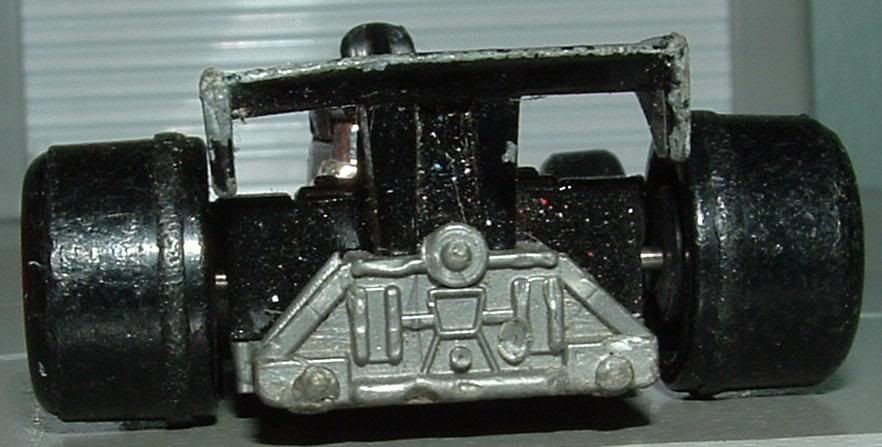
A blog focusing on 1/64 diecast from such popular brands as Hot Wheels, Matchbox, Johnny Lightning, M2 Machines, GreenLight, Tomica, Yat Ming, Majorette, MotorMax, Siku, Corgi, Guisval, Playart, Ertl, Zylmex, Racing Champions, & many more. Swifty's Garage features a daily Car Of The Day and news updates from your favorite brands!
Thursday, October 13, 2011
Race Car Of The Day: October 13, 2011
Today's car of the day is Tomica's 1977 Lotus 78 Ford.
The Lotus 78 'wing car' was a Formula One racing car used in the 1977 and 1978 seasons. It was designed by Peter Wright, Colin Chapman, Martin Ogilvie and Tony Rudd, and was the car that started the ground effect revolution in Formula One.
In early 1976, spurred on by the disappointing lack of pace of the ageing Lotus 72 the previous season, and the indifferent performance of the current Lotus 77, Chapman wrote a 27 page document detailing his ideas on low drag air penetration. After he had studied a de Havilland Mosquito fighter bomber, he paid close attention to its wing mounted radiators, and the hot air outlets that were designed to induce lift. Chapman realised that such a system inverted could give significant downforce. Careful examination of Bernoulli's principle of fluid dynamics confirmed his thoughts on the effects of an upturned aeroplane wing profile fitted to the car, and gave the document to his head of engineering Tony Rudd.
Rudd appointed a team to work on the project: chief designer Ralph Bellamy, vehicle engineer Martin Ogilvie and aerodynamicist Peter Wright. Rudd and Wright had previously worked for BRM, and before joining Lotus in 1970 had done a design study into the possibility of an inverted wing profile fitted to one of their cars. Rudd had tested a number of scale models, but lack of the right testing methods and BRM's declining fortunes meant development had never got beyond the experimental stage. However, Wright remembered their work and brought it into the project.
Wright then set about experimenting with F1 car body shapes using a wind tunnel and a rolling road, when by happy accident he began to get remarkable results in one of the models. Closer inspection found that as the rolling road's speed increased, the shaped underbody was being drawn closer to the surface of the road. Wright experimented with pieces of cardboard attached to the side of the model car body, and the level of perceived downforce produced was phenomenal. The results were presented to Colin Chapman, who gave the team free rein to come up with an F1 chassis design. After a round of design sketches and engineering drawings, and further work in the wind tunnel at Imperial College the car was put into production. Five examples were built, codenamed John Player Special Mk. III, otherwise known as the Lotus 78 which appeared in July 1976. Mario Andretti wanted to introduce the car early, possibly at the Dutch Grand Prix that year but was overruled by Chapman, as he didn't want other teams discovering what Lotus had achieved. The 78 was introduced at the first race of 1977, and proved to be the class car of the field that season, winning five races. The car proved relatively easy to set up and modify, with particular attention paid to the undercar aerodynamics and their interaction with the track surface, hence a stiffer suspension design which was required to maintain the aerodynamic effects.
For more information and pictures of the real car please visit: Lotus 78
This one is badged as "Lotus 78 Ford" as the car is by Lotus and the engine is by Ford (Cosworth specifically). And for those who like realistic replicas of racing machines, this is the example to get of this car. We'll probably never seen another version with the correct John Player tampos.
It was obvious that the 78 was something special though, as proved by Andretti and Gunnar Nilsson who won once in Belgium. When the car worked well it was almost uncatchable. Other teams started scrambling to design their own version for 1978. The problem they had was that they didn't know exactly what was so special about the car, as Chapman and other members of Lotus came up with any number of excuses to hide the real reason. That as well as the skirts, which hid any view of the underside of the car.
The 78 was good enough to still be a winner in early 1978, with Andretti and Ronnie Peterson scoring a win each and another three pole positions before it was replaced by the Lotus 79, which was as far ahead of the 78 as the 78 had been ahead of the rest of the field in 1977. The 78 was to see one further works team start, however. Owing to damage sustained to his 79 in practice, Ronnie Peterson was forced to use the reserve car, 78/3 (JPS-17), to qualify for the 1978 Italian Grand Prix. The car had not been maintained or developed by the team as they concentrated on the 79, and the car was hurriedly prepared for the race. Although his team mate Andretti predictably took pole position, the slower 78 was only good enough for fifth place on the grid for Peterson. Sadly, the Swede was caught up in a massive start line accident, which resulted in his car ramming the barriers nose-first, completely destroying the front end of the vehicle. Peterson later died owing to complications arising from the treatment he received following the crash.
The original development prototype, 78/1 (JPS-15), was sold to Hector Rebaque. He ran this car through his Rebaque privateer team in World Championship events during 1978 and 1979, and in non-Championship races into the early 1980s.
In all, the Lotus 78 took seven wins, nine pole positions and scored 106 points in its career.
Subscribe to:
Post Comments (Atom)






No comments:
Post a Comment